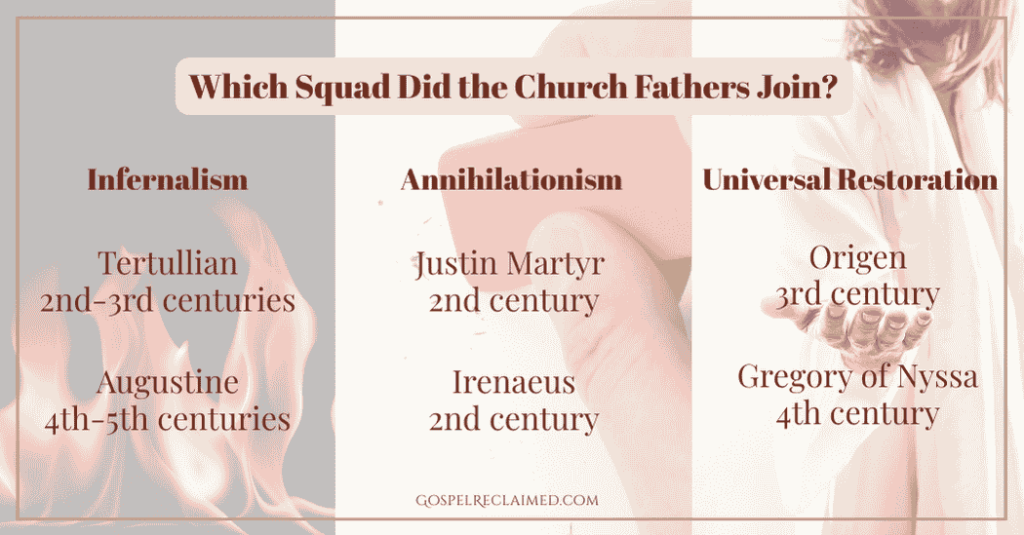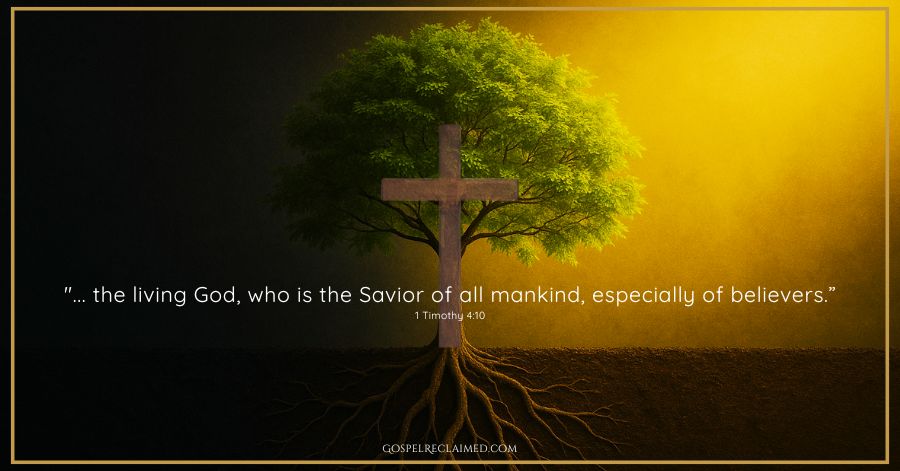⚠️ This blog isn’t about answers—it’s about awakening. Gospel Reclaimed is where I wrestle, wonder, and write about a gospel that’s far bigger, deeper, and more healing—a Father more faithful, a Savior more triumphant, and a Spirit more personal than religion ever taught me.
Let’s explore the three major views on the afterlife held by early Church Fathers: Infernalism (eternal hell), Annihilationism (eventual destruction), and Universal Restoration (ultimate reconciliation of all).
These perspectives shaped centuries of Christian thought and reflect how early believers wrestled with the nature of God’s justice, mercy, and purpose for creation.
In this post, we’ll unpack each view, examine the historical and philosophical roots of Infernalism—including its overlap with certain pagan ideas—and explain how it rose to prominence. We’ll also highlight why Universal Restoration offers a compelling alternative rooted in the character of Christ.
And at the end, you’ll find a simple comparison table to help keep the different views clear.
Infernalism: Eternal BBQ, Pagan Style
Welcome to Infernalism—the doctrine of eternal hellfire, where the unrepentant are said to receive a one-way ticket to endless conscious torment. According to this view, championed by heavy-hitters like Tertullian and Augustine, sinners spend forever in a fiery abyss, wailing and gnashing their teeth while divine justice rolls on without end.
Now here’s where things get interesting: Infernalism bears a striking resemblance to ancient pagan concepts. Think Tartarus—the Greek underworld where enemies of the gods were banished for eternal punishment. Or the underworlds of Mesopotamian and Egyptian mythology, filled with imaginative forms of torment for the wicked. In a world soaked in Greco-Roman thought, it’s no surprise that early Christian thinkers might have absorbed a few of these spicy cultural ingredients into their theology.
So why did Infernalism become so dominant?
Simple: it’s intense. It delivers drama, fear, and an urgent call to repentance—all things that made it very appealing to early church leaders. By the time Augustine’s City of God hit the shelves, Infernalism had become the theological mainstream. It was effective—and fear, as history shows, is a powerful motivator.
But wait—didn’t Jesus talk about hell more than anything else? Actually… no. Not even close.
➤ Click here to discover what He really said—and what He really meant.
Annihilationism: The Cosmic Delete Button
Next up: Annihilationism—the view that says instead of roasting forever, the wicked simply cease to exist. Advocated by early thinkers like Irenaeus and Justin Martyr (on their less fiery days), this perspective holds that the unrepentant aren’t eternally tortured, but ultimately “poof”—gone. No unending torment, no cosmic do-over. Just a final judgment, and then… lights out.
Annihilationism’s appeal lies in its moral coherence. The idea of eternal torture is hard to reconcile with a loving God—but the concept of a merciful end? That’s a little easier to digest. It draws from verses like Psalm 37:20, where “the wicked vanish like smoke,” and avoids the mythological baggage that Infernalism sometimes carries.
So why didn’t this view catch fire (pun intended)? Well, “Repent or be no more” doesn’t have the same dramatic punch as “Repent or burn forever.” It lacks the fear factor that fueled revival tents and firebrand preaching. And for some, divine justice just didn’t feel satisfying unless the wicked really felt it.
Universal Restoration: Cosmic Group Hug
Finally, we arrive at Universal Restoration—arguably the most hopeful view of them all. Championed by Church Fathers like Origen and Gregory of Nyssa, this perspective teaches that everyone will ultimately be saved. Hell, in this view, isn’t eternal punishment but a temporary, purifying process—a kind of spiritual rehab rather than a final sentence.
In other words, God’s love doesn’t give up. It reaches even the hardest hearts—yes, even the guy who invented decaf—and transforms them over time. Think of it as the theological equivalent of “everyone eventually makes it home.”
Universal Restoration leans on the belief that God’s mercy triumphs over judgment (James 2:13), and that divine justice is restorative, not retributive. Origen, with his rich use of allegory, suggested that “hell” symbolizes a corrective process, a divine time-out meant to lead the soul back to God. It’s a beautiful vision of redemptive love.
But not everyone was comfortable with it. As the Church became more aligned with imperial authority, the idea of eventual salvation for all—heretics, pagans, and all—was seen as too generous. Universalism was eventually labeled heresy at the Council of Constantinople, and Origen’s other views (like pre-existent souls) didn’t help his case.
Still, Universal Restoration remains a profound expression of the belief that in the end, love really does win.
Why Infernalism Won the Popularity Contest
So how did Infernalism—with its intense, punishment-heavy theology—rise to the top among afterlife views?
1. It had powerful emotional appeal.
Fear is a strong motivator, and Infernalism delivered vivid, unforgettable imagery: lakes of fire, gnawing worms, and endless weeping. It made for gripping sermons and kept people tuned in.
Compared to that, Annihilationism felt underwhelming, and Universal Restoration sounded almost too hopeful to be true. Infernalism struck a compelling balance between warning and control—useful for a Church focused on preserving order and obedience.
2. It resonated with the culture of the time.
The Greco-Roman world was no stranger to the idea of divine justice as a public spectacle—gladiator games, crucifixions, and mythologies full of gods dishing out cosmic payback. Infernalism felt familiar, like a spiritual continuation of cultural expectations, dressed in Christian language.
With thinkers like Augustine introducing doctrines like original sin, the idea that humanity deserved eternal punishment took root and spread fast.
3. It supported institutional power.
Infernalism conveniently raised the stakes of belief and obedience. If the alternative to orthodoxy was eternal torment, people were far less likely to wander.
Compared to it, Annihilationism and Universal Restoration lowered the urgency. After all, if the worst-case scenario is vanishing—or being restored eventually—there’s not as much fear to fuel control.
Infernalism, with its high-stakes consequence, gave the institutional Church a persuasive tool to keep people aligned.
The Church Fathers: Who’s Team What?
To help keep things clear, here’s a table outlining the key figures, the time periods they lived in, and which view of the afterlife they most strongly supported.
Note: some Church Fathers weren’t always crystal clear or consistent, so these placements reflect their most dominant theological leanings.
As for Augustine—arguably the most influential voice shaping Western Christian thought on the afterlife—his defense of Infernalism became so foundational that questioning it has, for centuries, risked raising theological eyebrows (or worse) before you even finish your sentence.

The Takeaway
The theological tug-of-war among the Church Fathers left us with three major views of the afterlife: Infernalism with its fiery judgment, Annihilationism with its final fade-out, and Universal Restoration—a vision of ultimate reconciliation and healing.
Infernalism may have taken the spotlight, but not because it was the most biblical or theologically sound. It rose to dominance because it delivered high-stakes fear and reinforced institutional control—a dramatic narrative that fit the times.
As for me? I stand with Universal Restoration. It’s the only vision where Jesus truly wins—not just over sin, but over every soul. Where grace doesn’t trickle, it floods.
Because if God’s love isn’t big enough to reach everyone…
If grace isn’t more abundant than sin…
If Jesus is called the Savior of the world—but somehow doesn’t save the world…
Then what exactly is the Good News?
Theology—you’re a wild ride. But when love leads, the view is worth it.
FAQs
What are the afterlife theories?
The afterlife theories of the early Church Fathers: Infernalism (aka HELL), Annihilationism, and Universal Restoration.
What is the annihilation doctrine?
No eternal torment, no cosmic redo, just a swift “you’re done” and a fade to black.
What does universal reconciliation mean?
It’s the only doctrine where Jesus is the ultimate victor, not just over sin but over every soul, where grace doesn’t just trickle, it floods.





